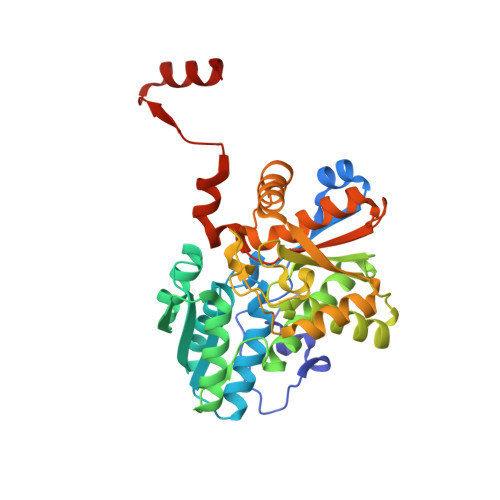Molecular Basis of Bacillus subtilis ATCC 6633 Self-Resistance to the Phosphono-oligopeptide Antibiotic Rhizocticin.
Petronikolou, N., Ortega, M.A., Borisova, S.A., Nair, S.K., Metcalf, W.W.(2019) ACS Chem Biol 14: 742-750
- PubMed: 30830751
- DOI: https://doi.org/10.1021/acschembio.9b00030
- Primary Citation of Related Structures:
6CGQ, 6NMX - PubMed Abstract:
Rhizocticins are phosphono-oligopeptide antibiotics that contain a toxic C-terminal ( Z) -l -2-amino-5-phosphono-3-pentenoic acid (APPA) moiety. APPA is an irreversible inhibitor of threonine synthase (ThrC), a pyridoxal 5'-phosphate (PLP)-dependent enzyme that catalyzes the conversion of O-phospho-l-homoserine to l-threonine. ThrCs are essential for the viability of bacteria, plants, and fungi and are a target for antibiotic development, as de novo threonine biosynthetic pathway is not found in humans. Given the ability of APPA to interfere in threonine metabolism, it is unclear how the producing strain B. subtilis ATCC 6633 circumvents APPA toxicity. Notably, in addition to the housekeeping APPA-sensitive ThrC ( BsThrC), B. subtilis encodes a second threonine synthase (RhiB) encoded within the rhizocticin biosynthetic gene cluster. Kinetic and spectroscopic analyses show that PLP-dependent RhiB is an authentic threonine synthase, converting O-phospho-l-homoserine to threonine with a catalytic efficiency comparable to BsThrC. To understand the structural basis of inhibition, we determined the crystal structure of APPA bound to the housekeeping BsThrC, revealing a covalent complex between the inhibitor and PLP. Structure-based sequence analyses reveal structural determinants within the RhiB active site that contribute to rendering this ThrC homologue resistant to APPA. Together, this work establishes the self-resistance mechanism utilized by B. subtilis ATCC 6633 against APPA exemplifying one of many ways by which bacteria can overcome phosphonate toxicity.
Organizational Affiliation:
Department of Biochemistry , University of Illinois at Urbana-Champaign , Roger Adams Laboratory, 600 S. Mathews Ave. , Urbana , Illinois 61801 , United States.















